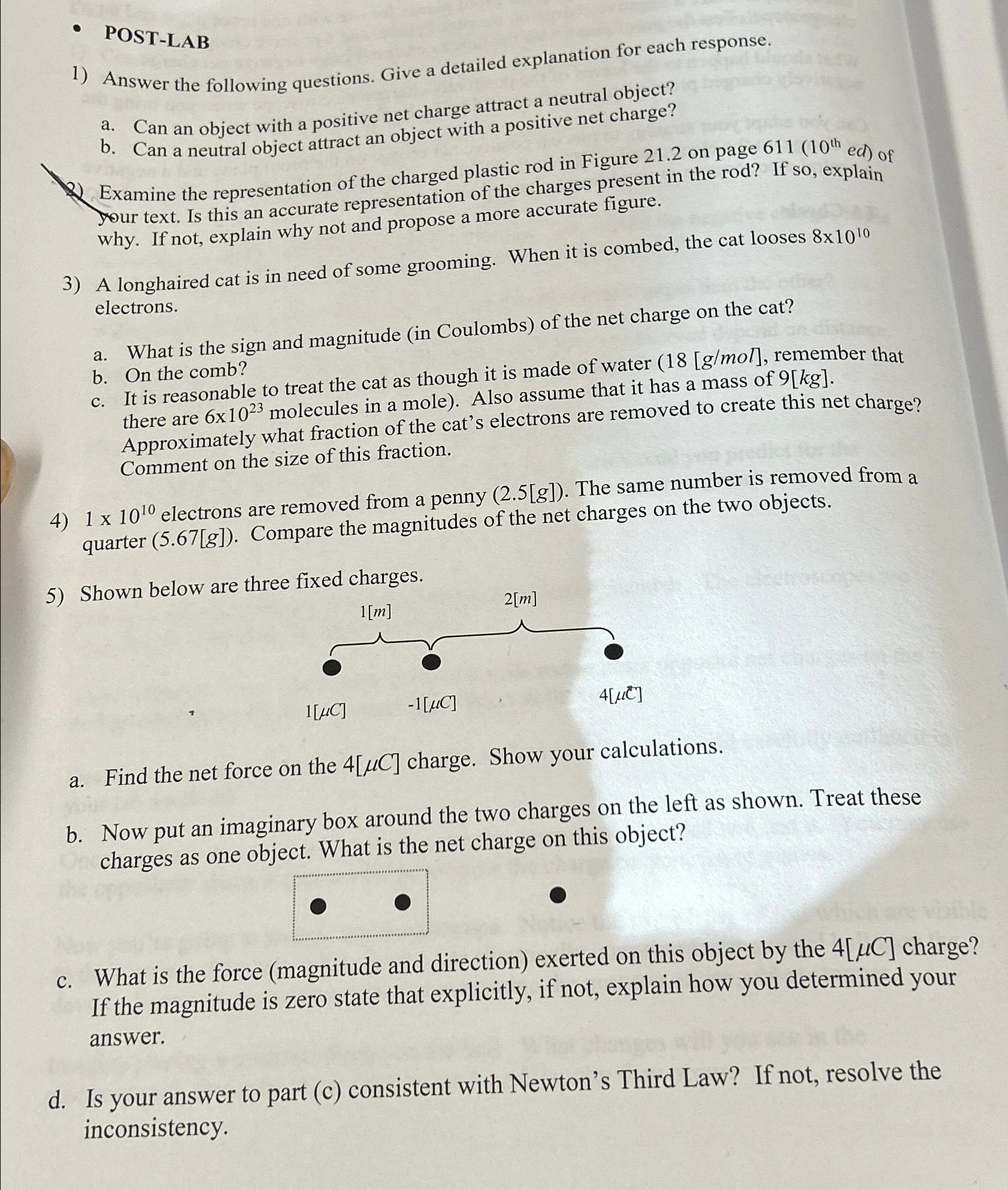Answered step by step
Verified Expert Solution
Question
1 Approved Answer
POST - LAB Answer the following questions. Give a detailed explanation for each response. a . Can an object with a positive net charge attract
POSTLAB
Answer the following questions. Give a detailed explanation for each response.
a Can an object with a positive net charge attract a neutral object?
b Can a neutral object attract an object with a positive net charge?
Examine the representation of the charged plastic rod in Figure on page of Four text. Is this an accurate representation of the charges present in the rod? If so explain why. If not, explain why not and propose a more accurate figure.
A longhaired cat is in need of some grooming. When it is combed, the cat looses electrons.
a What is the sign and magnitude in Coulombs of the net charge on the cat?
b On the comb?
c It is reasonable to treat the cat as though it is made of water remember that there are molecules in a mole Also assume that it has a mass of Approximately what fraction of the cat's electrons are removed to create this net charge? Comment on the size of this fraction.
electrons are removed from a penny The same number is removed from a quarter Compare the magnitudes of the net charges on the two objects.
Shown below are three
a Find the net force on the charge. Show your calculations.
b Now put an imaginary box around the two charges on the left as shown. Treat these charges as one object. What is the net charge on this object?
c What is the force magnitude and direction exerted on this object by the charge? If the magnitude is zero state that explicitly, if not, explain how you determined your answer.
d Is your answer to part c consistent with Newton's Third Law? If not, resolve the inconsistency.

POST-LAB 1) Answer the following questions. Give a detailed explanation for each response. a. Can an object with a positive net charge attract a neutral object? b. Can Examine the representation of the charged plastic rod in Figure 21.2 on page 611 (10th ed) of your text. Is this an accurate representation of the charges present in the rod? If so, explain why. If not, explain why not and propose a more accurate figure. 3) A longhaired cat is in need of some grooming. When it is combed, the cat looses 8x1010 electrons. a. What is the sign and magnitude (in Coulombs) of the net charge on the cat? b. On the comb? c. It is reasonable to treat the cat as though it is made of water (18 [g/mol], remember that there are 6x1023 molecules in a mole). Also assume that it has a mass of 9[kg]. Approximately what fraction of the cat's electrons are removed to create this net charge? Comment on the size of this fraction. 4) 1 x 100 electrons are removed from a penny (2.5[g]). The same number is removed from a quarter (5.67[g]). Compare the magnitudes of the net charges on the two objects. 5) Shown below are three fixed charges. 1[m] -1[C] 2[m] 4[C] 1[C] a. Find the net force on the 4[C] charge. Show your calculations. b. Now put an imaginary box around the two charges on the left as shown. Treat these charges as one object. What is the net charge on this object? c. What is the force (magnitude and direction) exerted on this object by the 4[C] charge? If the magnitude is zero state that explicitly, if not, explain how you determined your answer. d. Is your answer to part (c) consistent with Newton's Third Law? If not, resolve the inconsistency.
Step by Step Solution
There are 3 Steps involved in it
Step: 1
Lets address each question one by one 1a Can an object with a positive net charge attract a neutral object Yes an object with a positive net charge can attract a neutral object This is because the ele...
Get Instant Access to Expert-Tailored Solutions
See step-by-step solutions with expert insights and AI powered tools for academic success
Step: 2

Step: 3

Ace Your Homework with AI
Get the answers you need in no time with our AI-driven, step-by-step assistance
Get Started


